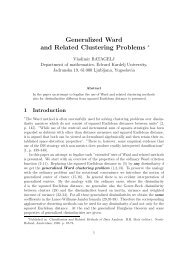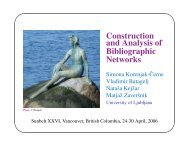'Advanced Network Analysis / Pajek: Large ... - Vladimir Batagelj
'Advanced Network Analysis / Pajek: Large ... - Vladimir Batagelj
'Advanced Network Analysis / Pajek: Large ... - Vladimir Batagelj
You also want an ePaper? Increase the reach of your titles
YUMPU automatically turns print PDFs into web optimized ePapers that Google loves.
V. <strong>Batagelj</strong>: <strong>Analysis</strong> and visulization of large networks with <strong>Pajek</strong> 106<br />
✬<br />
✫<br />
. . . <strong>Network</strong>s from data tables<br />
Suppose that the property q has the range Q. If Q is finite (it can always be<br />
transformed in such set by partitioning the set Q and recoding the values)<br />
we can assign to the property q a two-mode network K ×q = (K, Q, E, w)<br />
where (k, v) ∈ E iff q(k) = v, and w(k, v) = 1.<br />
Also, for properties qi and qj we can define a two-mode network qi ×qj =<br />
(Qi, Qj, E, w) where (u, v) ∈ E iff ∃k ∈ K : (qi(k) = u ∧ qj(k) = v),<br />
and w(u, v) = card({k ∈ K : (qi(k) = u ∧ qj(k) = v)}).<br />
We define [qi × qj] T = qj × qi.<br />
It holds qi × qj = [K × qi] T ∗ [K × qj] = [qi × K] ∗ [K × qj].<br />
We can join a pair of properties qi and qj also with respect to the third<br />
property qs: we get a two-mode network [qi×qj]/qs = [qi×qs]∗[qs×qj].<br />
Methodenforum der Fakultät für Sozialwissenschaften, Universität Wien, 21-22. 6. 2007 ▲<br />
❙ ▲<br />
▲<br />
● ❙ ▲<br />
▲<br />
☛ ✖<br />
▲<br />
✩<br />
✪


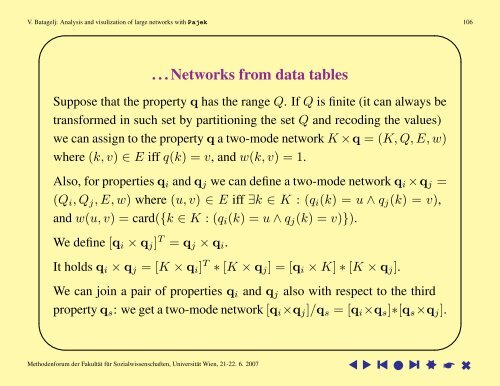
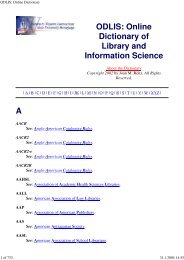
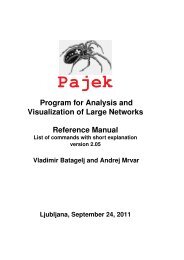
![VLADIMIR BATAGELJ [01467] Personal bibliography for the period ...](https://img.yumpu.com/8164783/1/184x260/vladimir-batagelj-01467-personal-bibliography-for-the-period-.jpg?quality=85)
